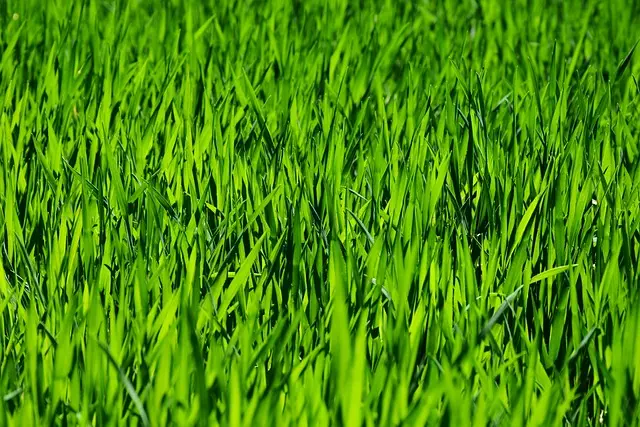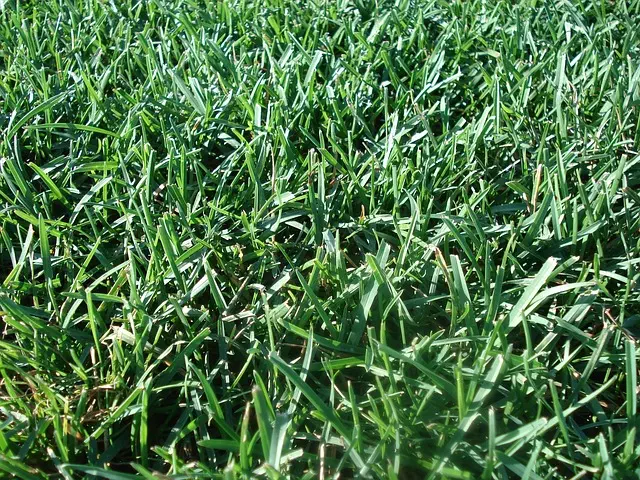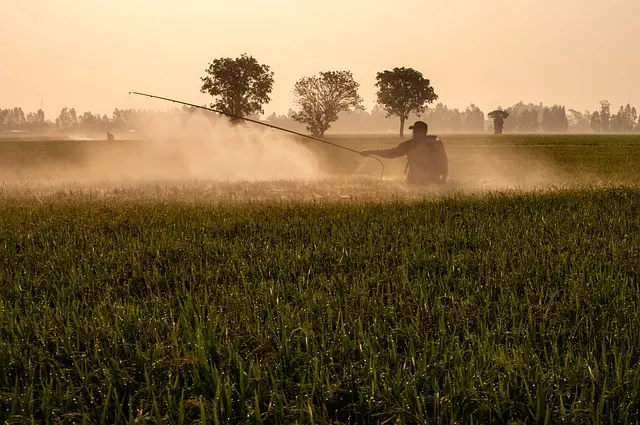To achieve a thriving lawn, lawn care and landscaping professionals must tailor maintenance strategies according to regional climates and specific turfgrass species. For cool-season grasses like Kentucky bluegrass and fescues, this includes routine mowing, aeration, and fertilization during their active periods. Warm-season grasses such as Bermuda and Zoysia require adjusted irrigation schedules that align with their dormancy cycles in colder conditions. Soil pH balance, customized fertilization, precise watering regimens, and understanding local climates are all critical for both cool and warm-season grasses to thrive. Seasonal lawn care practices include spring cleaning, aeration, and balanced fertilization; efficient irrigation in summer to prevent drought stress; fall fertilization and overseeding for winter readiness; and year-round deep watering for resilient root systems. Effective irrigation, mulching, and the use of smart controllers are essential for conserving water and maintaining plant health. Soil testing and precise fertilization are foundational for nutrient balance, while Integrated Pest Management (IPM) focuses on preventative measures to reduce the reliance on synthetic chemicals. Aeration and overseeding enhance turf density and resilience, ensuring the lawn can withstand various environmental pressures throughout the year. By adopting these comprehensive strategies, homeowners and landscaping professionals can maintain a lush, dense, and aesthetically pleasing lawn that endures diverse conditions with vigor, emphasizing sustainable and eco-friendly practices under the Lawn Care and Landscaping umbrella.
Navigating the complexities of maintaining a lush, green turf requires a blend of scientific knowledge, practical skills, and strategic planning. This comprehensive guide delves into the essentials of lawn care and landscaping, offering insights and actionable advice for every season. From understanding the diverse maintenance needs of various turfgrass types to mastering organic pest control, each section is crafted to empower you with the tools and techniques necessary for optimal turf management. Explore the intricacies of soil testing, irrigation strategies, and mowing practices that contribute to a thriving lawn environment. As we address the challenges posed by climate change and the importance of water conservation, you’ll learn to implement sustainable, long-term care solutions. Whether you’re aiming for a pristine sports field or a picturesque backyard oasis, this article serves as your roadmap to achieving turfgrass perfection, ensuring that your lawn stands out as a testament to meticulous care and attention.
- Understanding Turfgrass Types and Their Maintenance Needs
- Seasonal Lawn Care Practices for Vibrant Turf
- Effective Lawn Irrigation Strategies for Optimal Growth
- The Role of Soil Testing and Fertilization in Maintaining a Healthy Lawn
- Integrated Pest Management: Controlling Pests and Diseases Organically
- Aeration and Overseeding: Ensuring Turf Resilience and Density
Understanding Turfgrass Types and Their Maintenance Needs

Turfgrass types vary widely, each with distinct maintenance needs that are crucial for a thriving lawn. A deep understanding of these grass varieties is essential for effective lawn care and landscaping practices. For instance, cool-season grasses like Kentucky bluegrass and fescues thrive in temperate climates, requiring regular mowing and aeration during their active growth periods to maintain density and vigor. In contrast, warm-season grasses such as Bermuda and Zoysia excel in hotter conditions and demand different care, like reduced irrigation as they become dormant in colder months. Understanding the specific requirements of each turfgrass type, including their optimal soil pH, fertilization schedules, and watering habits, is key to successful lawn management and landscaping design. Landscapers must tailor their care strategies to the local climate and the particular grass species to ensure a lush, healthy lawn that withstands environmental challenges and foot traffic. By mastering these nuances, professionals in lawn care and landscaping can deliver exceptional results that stand the test of time and environmental fluctuations.
Seasonal Lawn Care Practices for Vibrant Turf

Effective seasonal lawn care practices are pivotal for maintaining vibrant turf that withstands environmental challenges and thrives throughout the year. During the spring, focus on raking away debris, aerating compacted soil, and fertilizing the lawn to encourage healthy growth. It’s crucial to select a balanced fertilizer that supports both root development and leaf growth. Regular mowing at the correct height for the grass species ensures a dense turf that naturally resists weeds. As temperatures rise in summer, irrigation becomes key to preventing drought stress. Efficient watering practices, such as deep, infrequent watering, promote deeper root growth, leading to more resilient lawns. Fall is a time for final fertilization to replenish nutrients used up during the growing season and to prepare the grass for winter dormancy. Lastly, in autumn and early winter, overseed bare spots to improve turf density and resilience against the harshness of the coming cold months. By following these seasonal guidelines, lawn care and landscaping professionals can cultivate a lush, resilient turf that is both aesthetically pleasing and environmentally sustainable. Implementing a tailored lawn care plan that addresses the unique needs of each season is essential for achieving and maintaining a vibrant landscape.
Effective Lawn Irrigation Strategies for Optimal Growth

Effective lawn irrigation is a cornerstone of a thriving landscape, ensuring optimal grass growth and overall plant health. To achieve this, it’s imperative to understand the specific water needs of your turf, which can vary based on climate, soil type, and local weather patterns. A tailored irrigation schedule, utilizing smart controllers that adjust to real-time weather data, can significantly enhance efficiency and conserve water. Drip or soaker hoses are ideal for targeted watering around plant beds, reducing unnecessary moisture on paved areas. Deep, infrequent watering encourages root growth, making the lawn more resilient against drought conditions.
Incorporating a combination of irrigation methods, such as sprinkler systems and hand-watering for newly seeded or sodded areas, ensures even distribution and moisture penetration at appropriate depths. Lawn Care and Landscaping professionals often recommend mulching around irrigation zones to minimize evaporation and runoff. Additionally, the timing of watering is crucial; early morning or late evening are optimal to reduce evaporation. Regular maintenance checks on irrigation systems prevent leaks and malfunctions that can lead to water waste. By adopting these strategies, homeowners and landscapers can maintain a lush, green lawn while respecting environmental constraints and promoting sustainable practices.
The Role of Soil Testing and Fertilization in Maintaining a Healthy Lawn

A robust turf management regimen is pivotal for cultivating a lush, resilient lawn. Central to this regimen is the practice of soil testing and strategic fertilization, both of which are integral components of effective lawn care and landscaping practices. Soil testing allows for the identification of nutrient deficiencies or imbalances, ensuring that the corrective measures are taken to maintain optimal soil pH levels and micronutrient availability. This analysis informs gardeners on the types and quantities of fertilizers needed to nourish the grass effectively, promoting vigorous growth, disease resistance, and a vibrant green hue.
Fertilization, a cornerstone of lawn care and landscaping, provides the necessary macronutrients that plants require for photosynthesis and overall health. A well-planned fertilization schedule, tailored to local soil conditions and grass species, helps manage the growth rate and improves turf density. It’s crucial to apply fertilizers at appropriate times throughout the growing season to avoid nutrient burn during peak growth periods or when temperatures are excessively high. By adhering to these practices, lawn care professionals can ensure that the soil remains a fertile foundation for a healthy lawn, contributing to the aesthetic appeal and functionality of landscaped environments.
Integrated Pest Management: Controlling Pests and Diseases Organically

Integrated Pest Management, commonly known as IPM, is a strategic approach to turf management that focuses on controlling pests and diseases organically. This method emphasizes the prevention of pest problems before they arise, rather than reacting to them after they have become established. By analyzing the lifecycle of pests and the conditions favorable to their survival, lawn care professionals can implement targeted measures to disrupt these cycles early on. This proactive approach not only minimizes the reliance on chemical pesticides but also ensures a healthier, more resilient turf.
Healthy turf is naturally better equipped to resist and recover from pest infestations and disease outbreaks. A robust lawn care program incorporates IPM by maintaining optimal soil conditions, selecting appropriate grass varieties for the local climate, and ensuring proper irrigation and aeration practices. These strategies foster a dense, vigorous turf that can outcompete weeds and pests. Additionally, landscaping practices that promote biodiversity within the ecosystem encourage beneficial insects and microorganisms that assist in naturally controlling harmful organisms. By adopting these IPM techniques, lawn care and landscaping professionals can deliver sustainable and effective outcomes for clients seeking organic turf management solutions.
Aeration and Overseeding: Ensuring Turf Resilience and Density

Maintaining a resilient and lush lawn requires a comprehensive approach to care, which includes regular aeration and overseeding as fundamental practices in any effective turf management regimen. Aeration serves a critical function by alleviating soil compaction, allowing water, air, and nutrients to penetrate the roots of your grass, thereby promoting healthy root growth and overall plant health. This process also helps reduce thatch build-up, which can otherwise suffocate the lawn and lead to disease and pest issues. For lawn care professionals and enthusiasts alike, understanding the timing and frequency of aeration is key; typically, early spring or fall is optimal for this procedure.
Following aeration, overseeding is the next step in enhancing turf density and vigor. This practice involves sowing grass seed into existing turf to fill in thin areas and improve the lawn’s resilience against foot traffic, drought, and other environmental stressors. The choice of seed variety should be tailored to the local climate and conditions to ensure successful germination and establishment. Landscaping companies specializing in lawn care often employ a strategic overseeding approach that includes selecting the right grass type for the region, ensuring that the seeds are evenly distributed, and maintaining consistent moisture levels for optimal seed growth. This combination of aeration and overseeding not only improves turf quality but also contributes to the long-term sustainability and aesthetic appeal of your landscape. Implementing these practices as part of a regular lawn care routine can significantly enhance the resilience and density of your lawn, making it a vibrant component of your property’s overall landscaping.
Lawns are a testament to the harmony between aesthetics and ecological balance, a subject expertly navigated throughout this discussion on turf management. By delving into the specifics of understanding various turfgrass types and their maintenance needs, seasonal lawn care practices, optimal irrigation techniques, soil testing, fertilization, pest control, and aeration with overseeding, readers are now equipped with comprehensive insights essential for maintaining vibrant turf. These strategies, when implemented as part of a holistic lawn care and landscaping approach, can lead to a resilient and lush landscape that stands the test of time and environmental challenges. Implementing these practices will not only enhance the visual appeal of your lawn but also promote a healthier environment, ensuring that your turf remains both beautiful and robust throughout the seasons.


